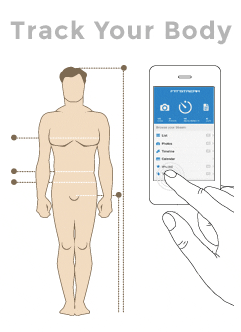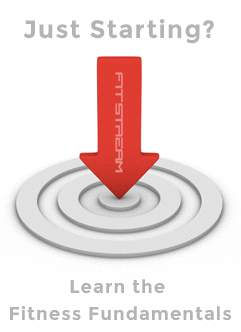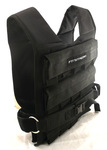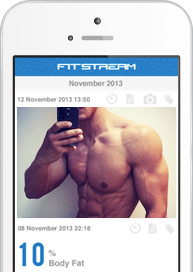Measuring body fat is an important metric that gives insight into body composition. It represents the percentage of body weight that is made up of fat as opposed to lean body mass (or LBM).
There are many ways to measure body fat and calipers are one practical tool that's cheap to buy and can be used at home to take this measurement.
 What are Calipers?
What are Calipers?
Calipers don't actually measure your body fat percentage directly but are used to measure the size of skin folds in various locations in the body.
Then, by using one of a number of different formulas these measurements can be turned into a body fat percentage estimate.
This is also commonly known as the 'skinfold test' or 'pinch test'.
How many measurements are taken and the locations measured will depend upon the skinfold method being applied. Commonly used methods include;
- Jackson-Pollack
- Parrillo
- Durnin / Womersley
Pros of Using Calipers
- Calipers themselves are very cheap to buy and easy to source
- When used correctly calipers are a good way of tracking changes in body composition over time
Cons of Using Calipers
- Calipers can provide inconsistent results and have a relatively high error rate if not used by an experienced person
- Body fat estimates are derived from formulas based on a statistical-model using national averages. Estimates will not be accurate for all people, such as athletes or those with high muscle mass (1)
- Calipers may not open wide enough to take measurements in obese subjects
How to Take Measurements Using Calipers
Technique is important when using calipers to take skinfold measurements. We have compiled these guidelines to help take more accurate caliper measurements;
- Take measurements on the right side of the body
- Grab a fold of skin and use the caliper to measure thickness to the nearest 0.5mm by reading the measurement dial
- Hold calipers perpendicular to the skinfold
- The measurement point of the skinfold should be half way along length of fold
- Accepting measurements (ACSM method)
- Take two readings and if they're not within 1-2mm of each other then retake
- Record measurements when 2 consecutive values are within 1-2 mm and take the average
Skinfold Measurement Sites
The different skinfold measurements sites used by the various methods are listed below;
| Skinfold location | Measurement Guidelines |
|---|---|
| Abdomen | Take a vertical skinfold 2cm to the right of the umbilicus |
| Biceps | Take a vertical skinfold over the belly of the muscle |
| Calf (medial) | Take a vertical skinfold in the middle of the calf muscle at the point of largest girth |
| Chest (pectoral) | For men only, take a diagonal skinfold (45 degree angle) half way between the nipple and outer chest (anterior axillary line) |
| Midaxillary | Can use vertical or horizontal skinfold (although must ensure consistency) on the midaxillary line (down the side of the torso) at the level of the xiphoid process (base of the centre column in rib cage). |
| Subscapular | Take a diagonal skinfold measured 1-2 cm below the inferior angle of the scapula (towards middle of back on right hand side). |
| Suprailiac | Take a slightly slanted skinfold just above the iliac crest (side of body above the pelvis) |
| Thigh | Take a vertical skinfold in the midline of the right thigh. Bodyweight should be shifted to the left foot. |
| Triceps | Take a vertical fold on the back of the upper arm, halfway between the elbow and top of shoulder. |
Body Fat % Formulas and Accuracy
Now that you know what calipers are, how they're used, and of the different measurement sites we're going to introduce you to some formulas to produce your actual BF estimate.
There are actually over 100 different formulas out there. Each equation relates to different populations, ages and characteristic types which skew the statistical model output. Obviously it's best to use a formula that more closely matches your own profile. We've chosen two of the most popular formulas used which should work for most of our readers.
It's also worth noting that you don't have to convert your skinfold measurements to a body fat estimate at all. Instead you can just monitor the changes in skinfold measurements at various body sites.
Also note that there are many calculators online that will take your measurements and give you your end body fat estimate automatically. What we're actually doing is showing your formula behind the scenes to give you insight into the factors at play.
Measuring Body Fat using Jackson Pollock Formula
The Jackson-Pollock formula is a commonly used and validated method that uses skinfold measurements to predict body fat.
There is an equation for men and women and two variations to the method which involve either taking 7 measurement readings or 3.
We're using the 7 site measurement method in the example below (2) (3).
| Step | Jackson Pollock Instructions |
|---|---|
| Step 1 |
Take fat measurements using the calipers in the following sites; Chest, Midaxillary, Subprailiac, Abdominal, Thigh, Triceps, Subscapular. |
|
Step 2 Men |
Calculate your overall bone density using the formula below; Bone Density = 1.112 (0.00043499 * (sum of all seven measurements in step one) + (0.00000055 * sum of all seven measurements in step one squared) - (0.00028826 * age in years) |
|
Step 2 Women |
Calculate your overall bone density using the formula below; Bone Density = 1.097 (0.00046971 * (sum of all seven measurements in step one) + (0.00000056 * sum of all seven measurements in step one squared) - (0.00012828 * age in years) |
|
Step 3 |
Once you have your bone density value from step two, you can calcuate your body fat percentage using the formula below; Body Fat Percentage = [(4.95 / Bone Density) - 4.5] * 100 |
Note that the formula above is the 7-site Jackson Pollock method because it involves taking 7 different body measurements that are then entered into the formula.
There is also 4-site and 3-site Jackson Pollock methods which require fewer measurements (but are less accurate as a result). The measurement points for these methods are shown below;
- Jackson Pollock 3 Site Method: Chest, Abdominal, Thigh
- Jackson Pollock 4 Site Method: Abdominal, Thigh, Tricep, Suprailiac
Measuring Body Fat Using the Parillo Formula
The Parillo equation for estimating body fat is another simple skinfold measurement method but it requires nine different body readings and has no gender differentiation.
| Step | Parillo Instructions |
|---|---|
| Step 1 |
Take fat measurements in millimeters using the calipers at the following sites; Chest, Abdominal, Thigh, Bicep, Triceps, Subscapular, Subprailiac, Lower Back, Calf |
|
Step 2 |
Perform calculation: Body Fat % = (Sum of 9 measurements in Step 1 x 27) / bodyweight in Lbs |
Example Body Fat Calculation
We've created the chart below to help illustate the calculation process. Here are the steps to populate it:
- Record the date and your bodyweight at the top of the sheet
- Take three readings for each body measurement site and populate columns M1, M2, M3
- Calculate the mean / average result of all three readings by adding them up and dividing by three
- Record the lowest and highest values for each measurement in the right hand column
- Using your preferred body fat % equation plug in your skinfold measurement site data and calculate your body fat % for each column. Now you should have body fat % values for your first, second and third measurements readings, including your average body fat result and highest and lowest value range.
- You can now calculate your Total Fat Mass and Total Fat Free Mass or Lean Body Mass by factoring your bodyweight % against your actual bodyweight
- For example if body fat percentage is 20% and you weight 100 lbs, your FM is 20 lbs and FFM is 80 lbs
Note that this chart is based on the Parillo equation and therefore captures 9 different measurements. If you use a different equation simple add or remove the appropriate measurement sites.
|
Date / Week Number |
Week 5 |
|
Body weight (Lbs) |
168 Lbs |
| Measurement Site | M1 | M2 | M3 | Average | Lowest | Highest |
|---|---|---|---|---|---|---|
| Bicep | ||||||
| Tricep | ||||||
| Chest | ||||||
| Abdominal | ||||||
| Subscapular | ||||||
| Suprailiac | ||||||
| Thigh | ||||||
| Lower Back | ||||||
| Calf | ||||||
|
Body Fat % (BF %) |
||||||
|
Total Fat Mass (FM) |
||||||
|
Total Lean Body Mass / Fat Free Mass (FFM / LBM) |
If you populate this table for yourself you will probably find that there is variance between most of the site readings (M1, M2, M3). Therefore the body fat % output will vary between these columns. By taking average readings of M1, M2 and M3 we can help smooth out the inaccuracies.
The value you now have is probably good enough for most people, but if you want to take things a step further to check accuracy you can work with your average highest and average lowest readings too as we've captured in the table above.
These two values represent your best and worst case body fat % range. If you take an average of your highest and lowest body fat, this should be very similar to the first average you calculated.
Start Tracking your Body Fat Percentage Today
The Fitstream Body Tracking tool is free to use and designed to track all important body metrics and capture body photos. You can build a story of how your body is changing over time.
Thousands of people around the world are using are system to stay motivated and inspire others with their progress.
References
- Journal of American Geriatric Society 1997; 45(7):837-843
- Jackson, A. S., & Pollock, M. L. (1978). Generalized equations for predicting body density of men. British Journal of Nutrition, 40, 497-504.
- Jackson, A. S., Pollock, M. L., & Ward, A. (1980). Generalized equations for predicting body density of women. Medicine and Science in Sports and Exercise, 12, 175-182.











